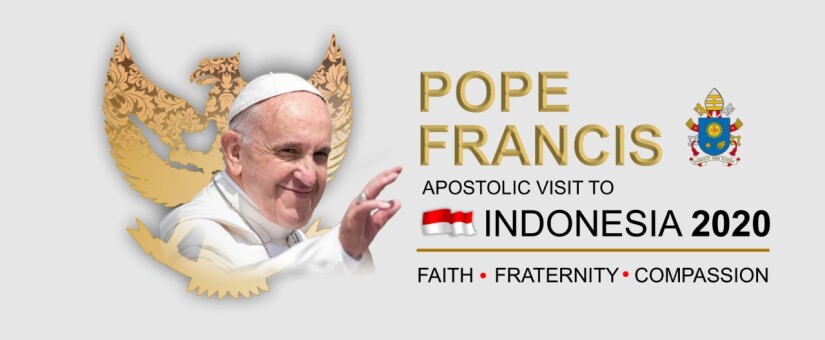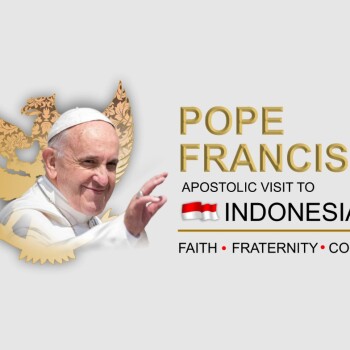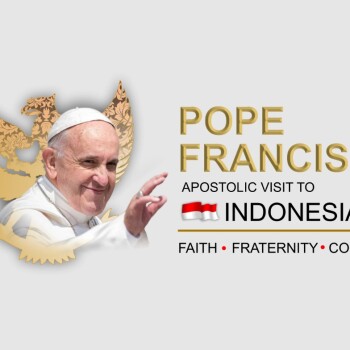
Address of His Holiness Pope Francis – Cathedral, 4 September 2024
APOSTOLIC JOURNEY OF HIS HOLINESS POPE FRANCIS
TO INDONESIA, PAPUA NEW GUINEA,
TIMOR-LESTE AND SINGAPORE
2-13 September 2024
Address at the Meeting with Bishops, Priests,
Deacons, Consecrated Persons,
Seminarians and Catechists
Jakarta Cathedral
4 September
Dear brothers and sisters, good evening!
I greet all present, the Cardinal, Bishops, priests, deacons, consecrated men and women, seminarians and catechists. I thank the President of the Bishops’ Conference for his words, as well as our brothers and sisters who shared their testimonies with us.
As you know, the motto chosen for this Apostolic Visit is Faith, Fraternity, Compassion. I think these are three virtues that express well both your journey as a Church and your character as a people, who are ethnically and culturally diverse. At the same time, you are characterized by an innate striving for unity and peaceful coexistence, as witnessed by the traditional principles of the Pancasila. I would now like to reflect with you on these three words.
The first is faith. Indonesia is a large country, with many natural riches, in terms of plants and wildlife, energy sources, raw materials and so on. If viewed superficially, such great wealth could be a reason for pride or arrogance, but when considered with an open mind and heart, this wealth can instead be a reminder of God, of his presence in the cosmos and in our lives, as Sacred Scripture teaches us (cf. Gen 1; Sir 42:15; 43:33). Indeed, it is the Lord who gives all this. There is not an inch of the marvellous Indonesian territory, nor a moment in the lives of its millions of inhabitants that is not a gift from God, a sign of his gratuitous and everlasting love as Father. Looking at all we have been given with the humble eyes of children helps us to believe, to recognize ourselves as small and beloved (cf. Ps 8), and to cultivate feelings of gratitude and responsibility.
Agnes talked about this when inviting us to live our relationship with creation and with our brothers and sisters, especially the most needy, through a personal and communal lifestyle marked by respect, civility and humanity, together with sobriety and Franciscan charity.
After faith, the second word in the motto is fraternity. A twentieth-century poet used a very beautiful expression to describe this attitude. She wrote that being brothers and sisters means loving each other by recognizing each other “as different as two drops of water” (W. Szymborska, “Nulla due volte accade”, in La gioia di scrivere. Tutte le poesie (1945-2009), Milano 2009, 45). That expression captures it perfectly. No two drops of water are alike, nor are two brothers or sisters, not even twins are completely identical. Living out fraternity, then, means welcoming each other, recognizing each other as equal in diversity.
This, too, is a value dear to the Indonesian Church and is made manifest through the openness with which you address the various internal and external realities encountered on a cultural, ethnic, social and religious level. In particular, your local Church values the contribution of all and generously offers assistance in every setting. This is important, because proclaiming the Gospel does not mean imposing our faith or placing it in opposition to that of others, but giving and sharing the joy of encountering Christ (cf. 1 Pet 3:15-17), always with great respect and fraternal affection for everyone. I invite you always to keep yourselves open and friendly to all – “hand-in-hand”, as Father Maxi said – prophets of communion, in a world where the tendency to divide, impose and provoke each other seems to be constantly increasing (cf. Apostolic Exhortation Evangelii Gaudium, 67).
As Sister Rina reminded us, it is important to try to reach everyone. In this regard, it is hoped that not only the texts of the word of God but also the teachings of the Church will be translated into Bahasa Indonesia in order to make them accessible to as many people as possible. Nicholas also pointed out the need to reach everyone, describing the mission of the catechist with the image of a “bridge” that unites. This struck me, and made me think of a wonderful vision in the great Indonesian archipelago of thousands of “bridges of the heart” uniting all the islands, and even more so of millions of such “bridges” uniting all the people who live there! Another beautiful image of fraternity would be an immense tapestry of threads of love that cross the sea, overcome barriers and embrace all diversity, making everyone “one heart and soul” (cf. Acts 4:32).
We come now to the third word: compassion, which is very closely related to fraternity. We know that compassion does not consist in giving alms to needy brothers and sisters, looking down on them from the “tower” of our own security and success. On the contrary, it consists in drawing us close to one another, removing everything that can prevent us from stooping down to touch those on the ground, lifting them up and giving them hope (cf. Fratelli Tutti, 70). Moreover, it means embracing their dreams and desires for freedom and justice, taking care of them, supporting them while also involving others, widening the “net” and the boundaries to create a great expansive dynamism of charity (cf. ibid., 203).
There are those who are afraid of compassion because they consider it a weakness. Instead, they champion, as if it were a virtue, the shrewdness of those who serve their own interests by keeping their distance from everyone, by not letting themselves be “touched” by anything or anyone, thus thinking they are more lucid and free in achieving their goals. This is an incorrect way of looking at reality. What keeps the world going is not the calculations of self-interest, which generally end up destroying creation and dividing communities, but offering charity to others. Compassion does not cloud the true vision of life. On the contrary, it makes us see things better, in the light of love.
In this regard, the architecture of this Cathedral’s main entrance, with its Marian focus, sums up very well what we have said. At the centre of the pointed arch is a pillar on which there is a statue of the Virgin Mary. It thus shows us that the Mother of God is above all a model of faith, but she also symbolically supports the entire edifice of the Church through her humble “yes” to God’s plan (cf. Lk 1:38). Yet the pillar represents Christ and the humble woman standing on that pillar seemingly bears with him the weight of the whole building, as if to say in the end that human labour and ingenuity cannot support itself. Mary, then, appears as an image of fraternity, a gesture of welcome in the middle of the main entrance to all those who wish to enter. Finally, she is also an icon of compassion, watching over and protecting God’s people who, with their joys and sorrows, labours and hopes, gather in the Father’s house.
Dear brothers and sisters, I would like to conclude these reflections by repeating what Saint John Paul II said when addressing Bishops, clergy and religious during his Visit here several decades ago. Quoting the following verse from the Psalms, “Laetentur insulae multae – Let the many islands rejoice” (Ps 96:1), he invited those listening to put it into practice by “bearing witness to the joy of the Resurrection and in giving your life so that even the most distant islands may ‘rejoice’ at hearing the Gospel, of which you are authentic preachers, teachers and witnesses” (Meeting with the Bishops, Clergy and Religious of Indonesia, Jakarta, 10 October 1989).
I too renew this exhortation, and I encourage you to continue your mission by being strong in faith, open to all in fraternity and close to one another in compassion. I bless you and thank you for all the many good things you do each day! I will pray for you and ask you, please, to pray for me. Thank you.



0 Comments